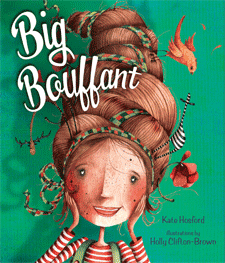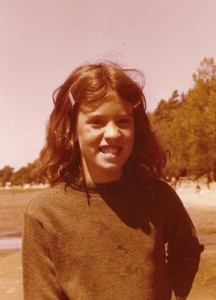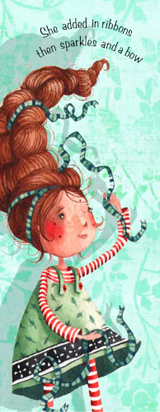
Ponytails and braids! Ponytails and braids! I don’t see anything but ponytails and braids! This class needs some fashion. This class needs some fun. I’ll find a hairdo to impress everyone.
Annabelle doesn’t want the same boring hairstyle that all the other girls have. When she spies a picture of her grandma, she has the perfect idea: a big bouffant! But how can she make her style stand up? And will her classmates really be impressed with her daring ’do?
Nominated for the Mockingbird Award
“{Big Bouffant} deals with a serious issue—defining one’s place
among one’s peers—in the most entertaining way imaginable.”
—ForeWord Magazine
Who Cares About Hair?
When it comes right down to it, many of us seem to spend an awful lot of time thinking about our hair. Perhaps this is because our hair follows us wherever we go, making an impression on everyone around us. It’s one way to say ‘here I am, and this is how I want to look’.
I believe hair becomes important to both girls and boys as soon as they have enough hair to style. My nieces were doing their own hair soon after they learned how to walk. The boys on my son’s soccer team sometimes wear mohawks, which seem to give them confidence. I think that’s the case with any favorite hairstyle; how you look can improve how you feel.

I experimented with many different hairstyles as a child. Sometimes, my hair was in serious need of taming, and sometimes it threatened to take over completely! Notice the need for barrettes here.
My hair just seemed to get bigger and bigger during the 80’s, and by the time I got to college, I had a boy from Texas tell me I had the biggest hair he’d ever seen! I wish I had thought to style all that hair in a fabulous bouffant.
When I taught elementary school, I never had a student with a bouffant, but I did have some who wore tiaras and feather boas to school, and I certainly came across children who dared to be different in other ways.
One of my favorite memories is of a fifth grader at Hong Kong International School who memorized the Gettysburg address, and would then go from classroom to classroom performing it. He was a big hit!
In Big Bouffant, Annabelle is brave enough to try out a dramatic hairstyle. Her classmates initially mock her, but she doesn’t care. Her confident attitude leads other kids to reconsider their position on bouffants; maybe this retro style isn’t so ridiculous after all. In fact, maybe it’s incredibly chic!
Annabelle eventually wins everyone’s respect, and this is what I hope kids will take away from the story; it’s important to think for yourself, even if you meet resistance from your peers. Most people are suspicious of new ideas, Why? Because change is scary. But over the course of history, it is the independent thinkers who are able to stick to their guns and eventually change the way the rest of us think.
About the Illustrator

Holly Clifton-Brown has illustrated many imaginative children’s books, including Big Bouffant (Carolrhoda Books). She is also the author and illustrator of Annie Hoot and the Knitting Extravaganza (Andersen Press USA). Holly lives in London. You can visit her website at www.hollycliftonbrown.co.uk.
I was very lucky to be paired with Holly Clifton Brown for these books. I especially love the depth of her illustrations. I think she achieves this richness by doing a lot of her work by hand before scanning it into the computer and manipulating it. She also uses many interesting textures like fabric and paper bags, but she integrates them seamlessly so that they do not distract the reader. Her sense of whimsy was just right for Big Bouffant and Big Birthday, and her palettes and patterns speak for themselves. If you are interested in learning more about how Holly works, check out her blog: hollycliftonbrown.blogspot.com.
Reviews
Posh Little
Crowding the Book Truck
Librarian Pirate
Through the Looking Glass Children’s Book Reviews
Interviews
Lerner Publishing Blog
Cynsations
Honors and Awards
A 2012 Texas Mockingbird Award Nominee
The 2012-2013 Alabama Camellia Children’s Choice Award Winner
A 2012 Independent Publisher Book Awards bronze medal winner
The Writing Process
Writing this story was a good lesson in listening to myself. I started Big Bouffant on an airplane in 2004. I was on my way to the Society of Children’s Book Writers and Illustrators conference in Los Angeles, and it seemed like the perfect time to begin a new story.
I decided to write about a girl who wants a bouffant. My sons thought that ‘bouffant’ was a funny word, and my husband and I enjoyed saying it as well. My younger son suggested writing a story called ‘giant bouffant’ which I think then became ‘big bouffant.’ The phrase, “All I really want is a big bouffant, A big bouffant is all I really want,” had been going through my head for a few weeks. Now all I needed was a plot.
The first draft was a long drawn-out affair in which Annabelle tried to emulate her town librarian’s bouffant. This draft also had Annabelle doing extensive research on Marie Antoinette’s various hairstyles. In later drafts, I incorporated a fabulous hairdresser uncle, a trusty friend and a bewildered mother. Eleven drafts later, the story was still plodding and lacked focus. I showed it to one person who thought it was the worst thing I’d ever written. I figured she was right and shoved it in a drawer.
This was my first mistake. My reader was both right and wrong; the version of the story she read was not good, but the idea was worth pursuing. At the time, I didn’t distinguish between the story and the essential idea.
Later, I showed the story to some other people who were more positive. I then decided to bring it to an SCBWI conference in 2009. An agent there liked the idea, but agreed that the format wasn’t working.
I made the story incredibly short, I tried it from a first person point of view, and I tried to make the language more musical. It was better, but not good enough. Finally, I tried the story in rhyme, and suddenly it worked!
Many picture book writers are told to avoid rhyme. Obviously, I had been avoiding it as well, but rhyme was exactly what this story needed. Carolrhoda Books, a division of Lerner Publishing, bought the rhyming version of Big Bouffant, along with its sequel, Big Birthday.
With the help of an excellent editor, I went on to make the rhyming more fluid, and the overall story more complex. We considered whether every single word in the story was the right word. This process was really enjoyable. We were working as a team, and I could see the story improving before my eyes.
When I think back to that rhyming voice in my head saying “All I really want is a big bouffant, A big bouffant is all I really want,” I realize that the story was in rhyme all along. Now, when I hear a voice telling me a story, I listen very carefully. Is that voice speaking in rhyme? Is it speaking in prose? What sort of tone does the voice have? Playful and bouncy? Wistful and dreamy? The final draft may end up being something else entirely, but it’s worth noticing what makes you excited about a story initially.
I have also become better at trusting my impulses for writing a story. In the case of Big Bouffant, I couldn’t wait to start the first draft, which is usually a good sign. The idea also has to have staying power for the writer because the gestation period for a story can be long. In this case, it took me five years to get to the final draft!


